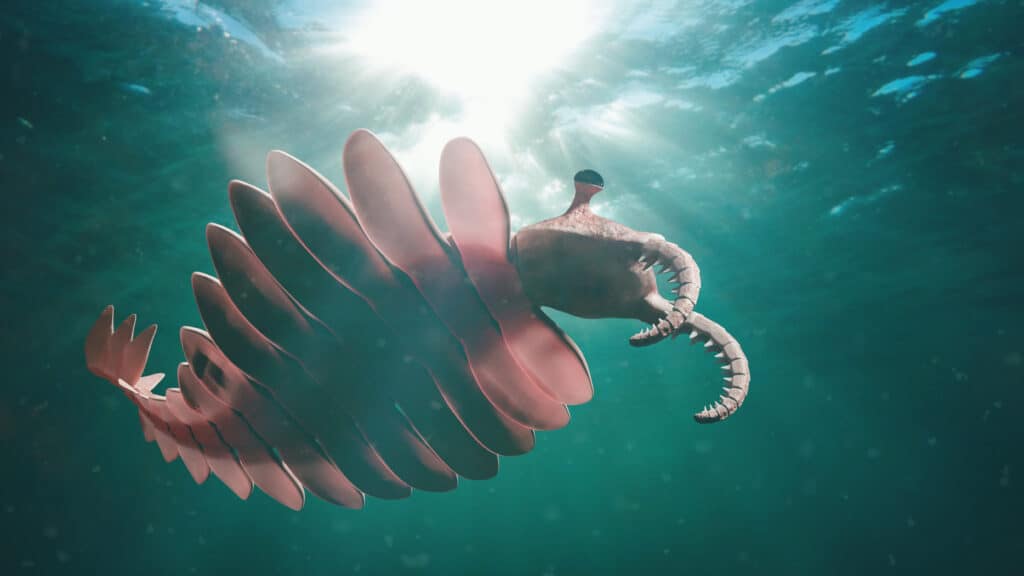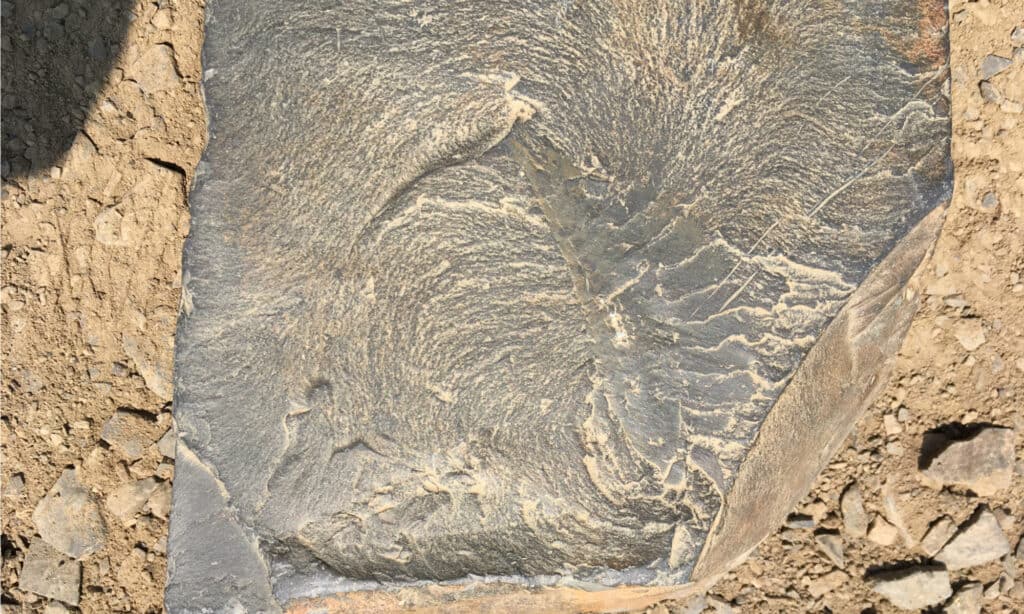Over half a billion years ago, the world’s strange apex predators were believed to be called the Anomalocaris, one of the largest hunters of its time. The decades-long misidentified Anomalocaris was a large, shrimp-like creature that existed during the Cambrian period which was the first geological period of the Palaeozoic Era. These creatures were first discovered in the Ogygopsis shale, and the first fossilized parts were thought to belong to three different creatures entirely. The interesting history of these large and unusual creatures gives us insight into how marine creatures may have evolved over millions of years underwater. Read on to discover everything you need to know about one of Earth’s first super predators!
What Is The Anomalocaris?

Anomalocaris was a large, shrimp-like creature that lived during the Cambrian period.
©Dotted Yeti/Shutterstock.com
The Anomalocaris is an extinct marine organism that is believed to be closely related to ancestral arthropods and they resembled a gigantic, modernized prawn or shrimp. These creatures had a body that was divided into different segments, with three pairs of up-facing extended fins and a large tail fan.
They were believed to be marine creatures that lived in the ocean, which is why their fossil remains can be found in shale. They were found throughout China, Utah, Greenland, and Australia and the name Anomalocaris means “unusual shrimp”.
These were carnivorous creatures that lived during the Cambrian period and are considered an extinct genus of radiodont which were an early-diverging group of arthropods. Scientists believe that the Anomalocaris is a distant relative of our modern crabs, shrimp, and lobsters.
The Anomalocaris did not survive the mass extinction at the end of the Cambrian period and they were eradicated along with 90% of the earth’s population during the Great Permian Extinction, leaving this mysterious creature a mystery that has intrigued scientists and researchers for centuries.
Who Discovered The Anomalocaris?

Part of an Anomalocaris fossil. It is only through the study of these fossils that scientists discover the true nature of the animals that came before humans.
©Gavin Howard/Shutterstock.com
These creatures were first identified in 1892 by Joseph Fredrick Whiteaves in British Columbia in Ogygyopsis shale. Other examples of the Anomalocaris were discovered by Charles Doolittle Walcott in Burgess shale.
The fossils of the Anomalocaris were misidentified and thought to belong to three different animals until the identification was corrected by Derek Briggs and Harry Whittington in 1985 through a journal article. The fossils that were discovered included the mouth, a frontal appendage, and a trunk.
Scientists then put the pieces together and drew up a diagram that could possibly show what the Anomalocaris could have looked like in its time. The misidentified fossilized pieces of the Anomalocaris were thought to be different from one another because of the mixture of mineralized and unmineralized parts which were collected between 1886 to 1888 by Richard McConnel. Later in 1928, a Danish paleontologist named Kai Henriksen found that the missing piece of the Anomalocaris was a carapace from Burgess shale.
In 1979, Derek Briggs found that the fossils of the Anomalocaris were not appendages, but rather the legs of the ancient creature. Later in 2011 and 2022, the compound eyes seen in the Anomalocaris were found at a palaeontological dig on Kangaroo Island in Australia which found that the eyes of this arthropod were advanced and evolved early before the evolution of jointed legs.
Were Anomalocaris Apex Predators?

The Anomalocaris is believed to have been an apex predator of species like the Opabinia
©Dotted Yeti/Shutterstock.com
The Anomalocaris is thought to be one of the earliest examples of an apex predator. They were carnivores who were a fast swimmer with an excellent vision from their compound eyes with thousands of lenses. Once the Anomalocaris caught up to its prey, it would grab them using their front limbs and sharp spikes.
Scientists believe the Anomalocaris to be a super apex predator because of their anatomy that allowed them to hunt their prey. The Anomalocaris had a predatory lifestyle and used their claws to grab and eat their prey, which helps scientists rule out the possibility of the Anomalocaris being a filter feeder.
How Big did Anomalocaris Get?

The Anomalocaris was approximately the length of a human
©Dotted Yeti/Shutterstock.com
The Anomalocaris was the Earth’s first super predator. Its body had approximately 11 lateral swimming flaps with a distinctive head and large eyes on stalks. Their two appendages had 14 segments each and were lined with sharp spikes. According to the fossil fragments, paleontologists believed these creatures could grow up to 3.2 feet long, but it is also possible for them to have reached lengths of 6 feet, as large as a human.
Where Did Anomalocaris Live?
The Anomalocaris lived in Asia, North America, and Australia in the Cambrian era, more than half a billion years ago. These are also the locations where the distinguishing fossils of the Anomalocaris were discovered to help the creature be identified.
Scientists believe that the Anomalocaris was a top predator at the time due to its size and impressive bodily anatomy that allowed them to be skillful predators in the ocean.
Up Next
- Ancient Oddities: 8 Extinct Sea Creatures
- The 10 Largest Shrimp (And Prawns) In The World
- The 8 Largest Animals That Have Lived Since Dinosaurs Went Extinct
The photo featured at the top of this post is © Dotted Yeti/Shutterstock.com
Sources
- Wikipedia, Available here: https://en.wikipedia.org/wiki/Anomalocaris
- Nature, Available here: https://www.nature.com/articles/news.2009.811#:~:text=Anomalocaris%2C%20a%20strange%20shrimp-like%20animal%20that%20lived%20around,Anomalocaris%20%27s%20mouth%20was%20incapable%20of%20such%20attacks.
- Why evolution is true, Available here: https://whyevolutionistrue.com/2010/11/17/a-new-anomalocaris-mystery/
- Bulletin of Geosciences, Available here: http://www.geology.cz/bulletin/contents/art1442#
FAQs (Frequently Asked Questions)
Is the Anomalocaris extinct?
The Anomalocaris went extinct 510-530 million years ago and the only proof that we have of these large creatures ever existing is through fossils.
What did the Anomalocaris eat?
The Anomalocaris was thought to eat hard-shelled prey like trilobites, but a paleontologist Whitey Hagedorn said that this was not possible since the creature had no broken mouth parts to indicate a diet of hard-shelled prey. Instead, it is possible that the Anomalocaris ate a carnivorous diet of worms or jellyfish and other soft-bodied creatures.
Thank you for reading! Have some feedback for us? Contact the AZ Animals editorial team.






